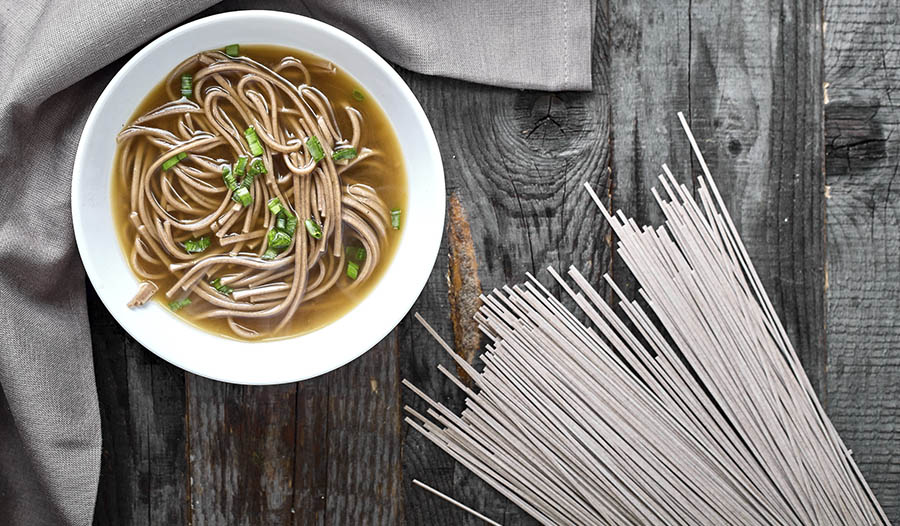Pasta Alternatives and their Nutritional Benefits

Many people want more out of their pasta dishes. Thankfully, there are several excellent pasta alternatives that offer many flavorful and nutritional benefits. These options are also ideal for those with gluten allergies.
Pasta is a major dietary staple throughout the world. In addition to being inexpensive, it provides an abundance of energy-boosting carbohydrates. However, for those who are looking to avoid heavy carbs or just want additional nutritional benefits not found in traditional pasta (which has very little), there are plenty of great substitutes out there. Here are several of the top pasta alternatives.
Low-Carb Shirataki Pasta
For individuals looking to drop weight, there's nothing else like shirataki noodles. Why? It's because some shirataki brands come in at a net of zero calories with no carbs or fat. Unlike some pasta alternatives, shirataki is not made of soy. This is important for those with soy allergies or those who simply want to avoid the product altogether.
These noodles are made from water and soluble fiber. Therefore, it's important to eat the prepared noodles quickly and not let them sit. Once cooked, the fiber may start to break down and turn into a mush. However, as long as they're eaten at the time of preparation, the noodles should maintain their texture and structure.
At worst, some brands of shirataki noodles max out at 20 calories per serving. Of course, that means it's still possible to consume an entire box (usually between 12 and 16 ounces) for under 100 calories. When considering healthy pasta, nothing else beats shirataki in terms of calorie, carb and fat options. However, it's worth pointing out that for someone looking to pick up a pasta alternative that tastes like the real thing, this really isn't the option. It might look like pasta, but it doesn't share the same taste. Of course, some prefer the flavor of shirataki.
While the overall calorie amount can vary, the average serving of shirataki sits right at around 2 calories per 3 ounces. It doesn't have any fat. Furthermore, the serving will have just .5 grams of carbs and .5 grams of fiber, which nets at zero carbs. A person could eat five servings (15 ounces) of the pasta in one sitting, and it would take about five minutes of walking to burn off all the calories. This makes shirataki a great alternative for anyone in search of a diet pasta.
Gluten-Free Bean Pasta
Individuals suffering from gluten allergies no longer need to avoid pasta nights; bean pasta is the way to go. Just as the name implies, the pasta is made from a variety of beans. Ingredients include black beans, mung beans, soybeans and others. While this pasta does come closer to replicating actual pasta taste, the different bean options help individuals experiment with different flavors.
Like many of the options on this list, bean pasta comes in various shapes and sizes. For example, it's possible to get traditional spaghetti, rotini, linguine and penne. Whatever kind of pasta shape someone is interested in, chances are they'll be able to find it in organic bean pasta form.
This pasta option comes in at around 212 calories per 2 ounces, depending on the kind of bean the pasta is made from. While higher in calories than regular pasta, it also comes with a substantially higher protein and fiber count at 10 grams of fiber per serving and 15 grams of protein.
Whole Wheat Pasta Alternative
When someone wants to stick with traditional grain pasta but swap out the simple carbs for complex carbohydrates, whole wheat pasta is the way to go. Whole wheat pasta naturally comes with a higher level of fiber than regular flour pasta. However, it's important to make sure the pasta is 100 percent whole wheat. Otherwise, it will likely contain simple carbs of flour.
There are a number of benefits when going with whole wheat pasta. The higher level of fiber aids in a feeling of fullness, which reduces the amount of food one will eat in a single serving. Plus, most whole wheat pasta is a bit tougher, which means it takes more chews to break the food down. Additional bites slow a person down when eating, which also helps cut down on the amount of food a person eats.
Each whole wheat pasta comes with varying nutritional benefits. Most are similar to flour pasta in terms of calories at around 160 to 180 calories per serving. However, a high-fiber pasta likely comes with 7 or more grams of fiber.
When considering whole wheat pasta, the best way to determine its health benefits is to directly compare it to enriched flour pasta as both are grains. A standard serving of regular pasta comes in around 221 calories, 8 grams of protein, 43 grams of carbs and 2.5 grams of fiber. However, 100 percent whole wheat pasta is 174 calories for the same amount, 7.5 grams of protein, 37.2 grams of carbs and 6.3 grams of fiber. So, while the protein level does dip a bit, whole wheat pasta comes with many desirable health benefits.
Gluten-Free Rice Pasta
Another gluten-free alternative is rice pasta. Most rice pasta is made up of brown rice and water, although there are some options that use eggs to help give it a like-pasta texture and boost the protein level. The exact nutrition facts will vary depending on if egg is included. However, a standard 2-ounce serving size generally comes with around 210 calories, 2 grams of fiber and 5 grams of protein. It also tips the scale at 43 grams of carbs.
Brown rice pasta shares similar nutrition facts to brown rice on its own. The nutritional value is similar to regular pasta as well, minus the gluten and simple carbs found in flour.
Soba Healthy Pasta
While soba pasta has long been a staple of health food stores, it's just now starting to receive more recognition. The Japanese noodle is made from buckwheat flour. This particular noodle is excellent as it can be consumed both hot and cold. Many other noodles completely lose flavor when served cold. For those looking for a pasta alternative to use with cold pasta salad dishes, soba is one such option.
While soba is made from a grain, it's a gluten-free grain. Therefore, individuals with gluten allergies can eat it. Soba is also noted as a reduced-calorie option. Since a 2-ounce serving comes in at around 198 calories, it is right in the same general area as most other pasta alternatives. A 2-ounce serving includes 6 grams of protein, 40 grams of carbs and no fiber. So, while there are several excellent health benefits attributed to soba, those looking to increase their fiber intake may want to try a different option. In terms of durability and texture, however, few other pasta alternatives can compete.
Everyone Is Different in Their Choices for Pasta Alternatives
There are all sorts of pasta options out there from near-zero calorie pasta to options packed with higher levels of fiber and protein. Choosing just comes down to what kind of dietary benefits one wants to obtain.
DISCLAIMER:This Wellness Hub does not intend to provide diagnosis...





























































































